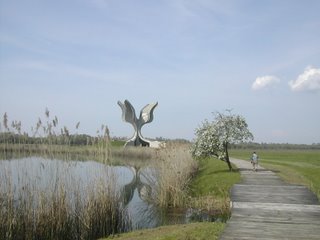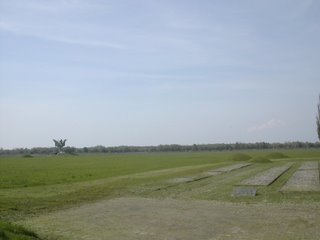Jasenovac Concentration Camp is still called "a whitewash", see https://balkaninsight.com/2018/08/27/croatia-must-not-whitewash-the-horrors-of-jasenovac-08-27-2018/
 Jasenovac Concentration Camp, Croatia. Dan Widing walks the path to the Memorial
Jasenovac Concentration Camp, Croatia. Dan Widing walks the path to the Memorial
Reparations. Where, when, why. US begins paying out reparations from France to Holocaust survivors and their heirs.
Jasenovac is one of some 20-22 concentration camps in Croatia WWII, See http://www.holocaustresearchproject.org/othercamps/jasenovac.html. Will the families of the dead here, or survivors, have their turn. The US is glad to pass out the reparations of others but so far unwilling to see the need in its own past.
 Jasenovac Concentration Camp, Croatia. Dan Widing walks the path to the Memorial
Jasenovac Concentration Camp, Croatia. Dan Widing walks the path to the Memorial1. Setting. At Jasenovac, follow the path anyway. It is set on railway ties leading past a lovely still pond to a deserted tulip-shaped, or flame-shaped monument, but the fountain-pool area inside runs dry. There is no illumination to the flame, and the fountain inside runs dry.
 Neglected interior, dry fount, Memorial at Jasenovac, Croatia
Neglected interior, dry fount, Memorial at Jasenovac, Croatia- Axis forces invaded what is now Croatia in 1941, and an independent pro-Nazi government state was formed within a short time. Targeted for extermination here were Jews, Serbs (Orthodox who would not convert to Roman Catholicism, and even some who did but found they were given no reprieve, just assured of salvation), and Gypsies. See http://www.holocaustresearchproject.org/othercamps/jasenovac.html, and http://www.srna.rs/novosti/425705/stepinac-planned-to-convert-serbia-to-catholicism-.htm.
- The versions of the involvement of church and other officials vary widely. * Do your own research. Example, http://www.jasenovac.org/exhibits.php, for a history of the Ustache activities. and is one of 22 such camps in its district, Croatia.
- That site is disturbing for its additional information, the role of Roman Catholic commanders, although the religion of any such participants in matters of the Holocaust was no deterrent to their activities.
- How many Orthodox were killed, so that the Roman Catholic factions could prevail. See 2018 http://www.spc.rs/eng/jasenovac_right_remembrance
 Jasenovac Concentration Camp, Croatia. Railroad transport for prisoners.
Jasenovac Concentration Camp, Croatia. Railroad transport for prisoners.The location suits obscurity and fast railroad transit for patrons. Drive west from Zagreb to the agricultural panhandle of Croatia, on the motorway, toward Osijek. The town of Jasenovac, eponymous,is near the Bosnian border with no highway sign. There was only a turnoff at the approximate spot, to find the site, now just this thumb-in-your-eye ignored park.
3. Minimal information. You will find little information of what happened here except for a Croatian language small relief map on a metal pedestal. Its relics and photos were apparently moved to the Holocaust Museum in Washington, D.C. See http://www.ushmm.org/museum/exhibit/online/jasenovac/.
But is that move just an excuse to get the nastiness out of Croatian memory, a short-lived fake attempt to memorialize something not featured at all now, so the place of Jasenovac both here and there is lost?
- A visit to the Holocaust Museum itself in the District of Columbia, Washington DC, however, showed nothing to us of Jasenovac. Nada. Ask and no-one had a clue. At home,
- I found this site for the Museum, so they do have something: Visit https://www.ushmm.org/search/results/?q=Jasenovac.
 Jasenovac Concentration Camp, Croatia. Mass graves and markers.
Jasenovac Concentration Camp, Croatia. Mass graves and markers.5. Obligation to remember. Is there such? I understand that the area was destroyed in the 1940's, as also happened at much of Bergen-Belsen, and Buchenwald, then abandoned during the 1990's wars. See www.ushmm.org/museum/exhibit/online/jasenovac/. What issues arise in maintaining sites for remembrance purposes. See http://news.bbc.co.uk/2/hi/europe/7827534.stm
Even where there was destruction after WWII, many sites of other concentration and extermination camps offer museums and exhibits. Of those, only at Mauthausen, from our travels, can a traveler see almost all the original buildings and the work-death sites. Should a museum or interactive displays at least should have been left open at Jasenovac. The area is essentially a wildlife preserve now, with a flat, mowed area with humps in the ground, and the outlines of rectangles, a museum building with windows broken and even the WC locked.
There was a bouquet of flowers from someone somewhere there, my notes note, but no memorials or even lists of names that I saw. There is nothing of the people who died there - not even stacks of glasses and shoes and passports and wallet photos and dental work, as at Auschwitz or Dachau.
7. It is probably too late to reconstruct anything meaningful at Jasenovac. The Memorial Museum is locked and windows broken.
 Jasenovac Concentration Camp, Croatia. Abandoned memorial museum.
Jasenovac Concentration Camp, Croatia. Abandoned memorial museum.If you go, you will be alone, except for a possible tractor and a cyclist or two.
 Jasenovac Extermination Camp. Now an agricultural pass-through, recreation area.agricultural, recreational
Jasenovac Extermination Camp. Now an agricultural pass-through, recreation area.agricultural, recreationalAt least look up the pictures of the horrors on the internet, and the discussions of religion-motivated executions, not just Nazi. Documents reviewed.
- We don't do much better in preserving history that does not favor our own self-image. We hide our Jim Crow era, with entry to the Jim Crow Museum by appointment. See http://www.ferris.edu/jimcrow/FAQ.
- We fake the nobility of our leaders' responses to 9/11 at NYC, pretending they did all they reasonably could before and after. Nationalism amok fails all of us. Why were not even their words followed by themselves as they abandoned the trail because it was difficult and headed for another country to invade, thinking it would be easy. No government is immune to self-serving.
In Croatia, even the German soldiers get better treatment than do those killed by them. See the Zagreb post on Miragoj Cemetery. Lists of German names, birth dates, dates of death, even though in a common grave. No complete listing of those killed at Jasenovac is at the site, that we saw.
There is a compendium of the dead, however, at this Jasenovac Memorial site, at http://www.jusp-jasenovac.hr/default.aspx?sid=6711. Eighty-three thousand killed.
=======================================================
 Jasenovac history through people. Burial memorial, Zagreb, Croatia. Cardinal Stepinac,
Jasenovac history through people. Burial memorial, Zagreb, Croatia. Cardinal Stepinac, What was the role of Cardinal Stepinac: We understand he offered the Orthodox the chance for conversion to Roman Catholicism before they were killed; but took no steps to stop the killing. Is that so unusual? No.
* This is the burial place at St. Peter's, Zagreb, of Archbishop Aloysius Stepinac, who had a role in preventing/enabling deaths by Nazi, depending on what sources you believe, that some see as heroic, others as a betrayal. See, for example, http://www.grayfalcon.blogspot.com/2005/04/forgotten-genocide. for a blog on Jasenovac, including comments on Stepinac. See also http://www.emperors-clothes.com/croatia/stepinacfile.doc" Is there pressure to keep Jasenovac under the radar for religious and political reasons?
There is an elaborate coffin on display near the altar in Zagreb at St. Peter's, that tour guides say is Stepinac's coffin, but other sources while we were there said he really is buried at the wall. See Jasenovac photos, discussion.
The era: Other exterminations. Jewish history in Croatia, including through WWII and after: See Jews in Croatia. The site points out that Dubrovnik has the second oldest synagogue in the world.
See http://www.holocaustresearchproject.org/othercamps/jasenovac.html. That site is disturbing for its additional information, the role of Roman Catholic commanders, although the religion of any such participants in matters of the Holocaust was no deterrent to their activities.
No comments:
Post a Comment